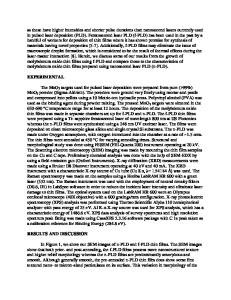Synthesis and Characterization of Laser Induced Graphene (LIG) and laser Reduced Graphene Oxide (lrGO) by using a pulsed
- PDF / 1,598,571 Bytes
- 9 Pages / 432 x 648 pts Page_size
- 0 Downloads / 420 Views
MRS Advances © 2019 Materials Research Society DOI: 10.1557/adv.2019.482
Synthesis and Characterization of Laser Induced Graphene (LIG) and laser Reduced Graphene Oxide (lrGO) by using a pulsed CO2 laser Juan P. Aguilar Gonzalez1, Ramón Gómez Aguilar2, Jaime Ortiz López1 1
Instituto Politécnico Nacional - IPN, Department of Physics, ESFM-IPN, Mexico.
2
Instituto Politécnico Nacional - IPN, Ciencias Básicas, UPIITA-IPN, Mexico.
ABSTRACT
We detail a method to produce graphite materials with a three-dimensional, flexible and porous structure obtained from the exposure to CO2 laser radiation. One of them is Laser Induced Graphene (LIG) grown from an insulating polyimide as raw material, and the other is laser reduced graphene oxide (lrGO), obtained from a graphene oxide (GO) thin film. For both materials, we describe their morphology, crystalline structure and electrical characterizations. These materials have important applications in organic electronics technology.
INTRODUCTION Flexible electronics or organic electronics has had a great boom in the last decade, since its applications include the development of thin film sensors and transistors (TFT). For this reason, there is great interest in the development of two-dimensional materials with properties that lead to new applications and increase the efficiency of devices that make use of them. Graphene-based nanomaterials have been widely studied due to their unique physical and chemical properties [1]. Depending on the method of synthesis, graphene can have porous and three-dimensional structures, which makes it a good candidate for use in a wide range of applications, such as electric contacts or in energy storage devices. Despite the advances, the current methods of porous graphene synthesis require a very elaborate methodology, which implies a high production costs reducing in its commercial potential. Finding low-cost alternative methods of synthesis is a topic of great current interest. In this direction, laser-assisted synthesis and processing
Downloaded from https://www.cambridge.org/core. University of Texas Libraries, on 08 Jan 2020 at 17:17:25, subject to the Cambridge Core terms of use, available at https://www.cambridge.org/core/terms. https://doi.org/10.1557/adv.2019.482
of graphene-like materials opens new ways for highly efficient and rapid techniques with potential scalable applications. Laser-induced graphene (LIG) was first obtained by J. Lin et al. [2] from Kapton polymer irradiated with a CO2 laser. Later on, several applications of LIG have been developed [3,4]. Photochemical reduction of graphene oxide can be produced by irradiation with several light sources, including pulsed and CW lasers [5,6]. The specific use of CO2 lasers to produce lrGO is not that common [7,8]. Laser induced synthesis of graphene and laser reduction of graphene oxide allow quick and controlled methods to obtain graphene-like materials in predetermined patterns with important applications in the fabrication of micro-electronic devices. In the case of lrGO, the
Data Loading...











